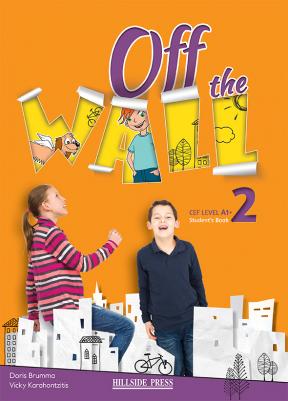A1-A2 / Off The Wall 1, 2, 3
Off The Wall 1
Off the Wall 1 is the first book in the Off the Wall series. It enables students to acquire a basic (Beginner’s) knowledge of English by following the extraordinary adventures of two siblings, their mysterious friend and his unusual dog.
Coursebook organisation
- a Let’s remember! section at the beginning of the book, revising among other things, the alphabet, colours, numbers, days, months, -s/-es plurals, possessive case and prepositions of place
- 30 theme-based lessons that are three pages each and introduce new vocabulary and grammar as well as giving reading, speaking, listening and guided writing practice
- 6 Take a peek! Sections, each comprising a lead-in page before every set of five lessons, which includes the objectives of the five lessons to come, a song, and brain-teasers introducing the themes of these lessons
- 6 Revision sections, one after every set of five lessons, each of which includes vocabulary and grammar tasks
- 6 How about that! sections, featuring a set of cross-cultural themes that give students the opportunity to take learning beyond the classroom
- an Out-Of-The-Box Jotter: an extra section at the back of the book, linked to the lessons that feature illustrations rather than photographs, encouraging free creative expression. Students jot down ideas, doodle or draw and release their imagination!
Lesson organisation
Reading
Each lesson starts with a reading text. The texts expose students to different genres, including dialogues, stories, blog posts, etc. Each reading text is followed by two reading comprehension activities to consolidate students’ understanding of the text.
Vocabulary and Grammar
The second page of each lesson contains vocabulary and grammar activities.
There are vocabulary activities which focus on the thematically-linked vocabulary already presented in the reading text, as well as an ‘extra words’ section which presents further useful vocabulary connected to the theme of the lesson.
In the grammar section of each lesson, students are presented with a clear and concise grammar table explaining the grammar phenomenon on which the lesson focuses. Following the grammar table are grammar activities which help reinforce students’ understanding of the language focus.
Listening, Speaking and Writing
The last page of each lesson is devoted to enhancing students’ listening, speaking and writing skills. The listening section of each lesson contains one or more listening activities of a variety of types that employ the vocabulary and/or grammar taught, in realistic contexts.
The activities in the speaking section give students the opportunity to practise the vocabulary and grammar they have been taught up to that point. The activities have been designed with the purpose of helping students gain the confidence they need to express themselves in English, in pairs or in larger groups, and so develop fluency.
There is a guided writing activity in every lesson. Students build key writing skills through the variety of writing tasks they are exposed to. Writing tips give students further help in acquiring a more thorough insight into the different types of writing tasks they will need to produce.
Pronunciation activities
From time to time, you will find pronunciation activities, which will help students with more challenging pronunciation issues. Targeted repeated pronunciation practice will lead students to a better understanding of English pronunciation and will help them overcome any difficulties.
Brain Breaks
The book is sprinkled with brain breaks in the form of questions, tongue twisters, riddles and brain-teasers, which give students a brief respite from the demands of structured learning.
Off The Wall 2
Off the Wall 2 is the second book in the Off the Wall series. The aim of this level is to consolidate the beginner’s knowledge students acquired the previous year and prepare them for the elementary level that they will complete the following year. Jack, Eliza, Pipkin and Multi will already be familiar to students from the first book in the series.
Coursebook organisation
- a Let’s remember! section at the beginning of the book, revising among other things, numbers, the time, prepositions of place, basic vocabulary, common verbs, present simple and past simple
- 30 theme-based lessons that are three pages each and introduce new vocabulary and grammar as well as giving reading, speaking, listening and guided writing practice
- 6 Take a peek! sections, each comprising a lead-in page before every set of five lessons, which includes the objectives of the five lessons to come, a song, and fun activities introducing the themes of these lessons
- 6 Revision sections, one after every set of five lessons, each of which includes vocabulary and grammar tasks
- 6 How about that! sections, featuring a set of cross-cultural themes that give students the opportunity to take learning beyond the classroom
- an Out-Of-The-Box Jotter: an extra section at the back of the book, linked to the lessons that feature illustrations rather than photographs, encouraging free creative expression. Students jot down ideas, doodle or draw and release their imagination!
Lesson organisation
Reading
Each lesson starts with a reading text. The texts expose students to different genres, including dialogues, stories, blog posts, etc. Each reading text is followed by reading comprehension activities to consolidate students’ understanding of the text.
Vocabulary and Grammar
The second page of each lesson contains vocabulary and grammar activities.
There are vocabulary activities which focus on the thematically-linked vocabulary already presented in the reading text, as well as an ‘extra words’ section which presents further useful vocabulary connected to the theme of the lesson.
In the grammar section of each lesson, students are presented with a clear and concise grammar table explaining the grammar phenomenon on which the lesson focuses. Following the grammar table are grammar activities which help reinforce students’ understanding of the language focus.
Listening, Speaking and Writing
The last page of each lesson is devoted to enhancing students’ listening, speaking and writing skills. The listening section of each lesson contains one or more listening activities of a variety of types that employ the vocabulary and/or grammar taught, in realistic contexts.
The activities in the speaking section give students the opportunity to practise the vocabulary and grammar they have been taught up to that point. The activities have been designed with the purpose of helping students gain the confidence they need to express themselves in English, in pairs or in larger groups, and so develop fluency.
There is a guided writing activity in every lesson. Students build key writing skills through the variety of writing tasks they are exposed to. Writing tips give students further help in acquiring a more thorough insight into the different types of writing tasks they will need to produce.
Pronunciation activities
From time to time, you will find pronunciation activities, which will help students with more challenging pronunciation issues. Targeted repeated pronunciation practice will lead students to a better understanding of English pronunciation and will help them overcome any difficulties.
Brain Breaks
The book is sprinkled with brain breaks in the form of questions, tongue twisters, riddles and brain-teasers, which give students a brief respite from the demands of structured learning.
Off The Wall 3
Off the Wall 3 is the third book in the Off the Wall series. The aim of this level is to develop pupils’ knowledge of English to A2 level in accordance with the Common European Framework of Reference for languages. The characters Jack, Eliza, Pipkin and Multi, who are featured throughout the book, are already familiar to pupils from the first two books in the series.
Coursebook organisation
- a Let’s remember! section at the beginning of the book, with tasks that help pupils remember what they learnt in previous years.
- 30 theme-based lessons that are three pages each and introduce new vocabulary and grammar as well as giving reading, speaking, listening and guided writing practice
- 6 Take a peek! sections, each comprising a lead-in page before every set of five lessons, which includes the objectives of the five lessons to come, a song, and fun activities introducing the themes of these lessons
- 6 Revision sections, one after every set of five lessons, each of which includes vocabulary and grammar tasks
- 6 How about that! sections, featuring a set of cross-cultural themes that give students the opportunity to take learning beyond the classroom
- an Out-Of-The-Box Jotter: an extra section at the back of the book, linked to the lessons that feature illustrations rather than photographs, encouraging free creative expression. Students jot down ideas, doodle or draw and release their imagination!
Lesson organisation
Reading
Each lesson starts with a reading text. The texts expose students to different genres, including dialogues, stories, blog posts, articles, emails, etc. They develop the theme of the lesson and present students with vocabulary and authentic functional language. They also introduce the grammar focus of the lesson. Each reading text is followed by reading comprehension activities to consolidate students’ understanding of the text.
Vocabulary and Grammar
The second page of each lesson contains vocabulary and grammar activities.
There are vocabulary activities which focus on the thematically-linked vocabulary already presented in the reading text, as well as an ‘extra words’ section which presents further useful vocabulary connected to the theme of the lesson.
In the grammar section of each lesson, students are presented with a clear and concise grammar table explaining the grammar phenomenon on which the lesson focuses. Following the grammar table are grammar activities which help reinforce students’ understanding of the language focus.
Listening, Speaking and Writing
The last page of each lesson is devoted to enhancing students’ listening, speaking and writing skills. The listening section of each lesson contains one or more listening activities of a variety of types that employ the vocabulary and/or grammar taught, in realistic contexts.
The activities in the speaking section give students the opportunity to practise the vocabulary and grammar they have been taught up to that point. The activities have been designed with the purpose of helping students gain the confidence they need to express themselves in English, in pairs or in larger groups, and so develop fluency.
There is a guided writing activity in every lesson. Students build key writing skills through the variety of writing tasks they are exposed to. A writing TIP! or REMEMBER box give students further help in gaining an insight into the different features of writing.
Brain Breaks
The book is sprinkled with brain breaks in the form of questions, tongue twisters, riddles and brain-teasers, which give students a brief respite from the demands of structured learning.



